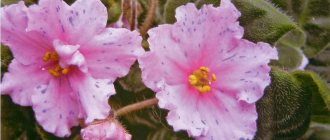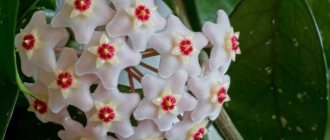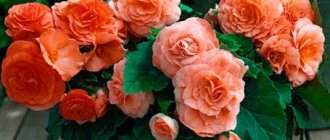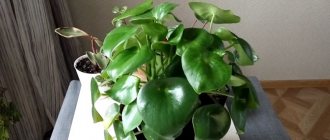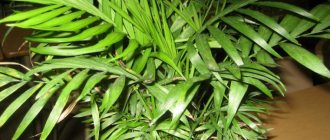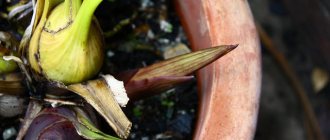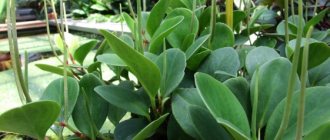How to select and prepare soil?
For hoya, a neutral or slightly acidic substrate is preferable. Many gardeners use ordinary garden soil. You can prepare a special mixture for growing hoya.
Based on leaf soil
- Leaf soil - 1 tsp.
- Humus – 1 hour.
- Clay-turf soil – 2 hours.
- Drainage is required.
Based on turf land
- Turf soil – 2 hours.
- Greenhouse land – 1 hour.
- Leaf part - 1 tsp.
Another option
Clay-turf soil - 2 hours.- Leaf soil - 1 tsp.
- Sand – 1 hour.
- Peat – 1 hour.
- Pieces of charcoal.
- Drainage layer.
The choice of soil for hoya depends primarily on the type of plant . Thus, one type of haworthia can live well in ordinary garden soil, while another variety requires special soil.
Therefore, before replanting a certain type of Hoya, you should study in detail what kind of soil and under what conditions the flower lives in the wild.
Types and varieties of Hoya
In indoor floriculture, Hoya is grown in different ways:
- as an ampelous plant in a flowerpot;
- like ivy around a support;
- like a bush with an erect stem.
To do this, select the appropriate type of Hoya.
Hoya majestic
Hoya Beautiful
Hoya Bella is an ampelous type of plant. Brought from India, perfectly adapted to high room temperatures and humidity. It has the appearance of a small shrub with creeping shoots, which are covered with small, thick, pointed leaves up to 2.5 cm in length. It blooms with medium-sized white flowers, the crown of which is a unique red or red-violet color.
Hoya Greenflower
Hoya Chlorantha is a very showy plant with elongated leaves and velvety flowers of white, brown or greenish color.
Hoya Fleshy
Hoya Carnosa is a very popular vine among gardeners. It grows naturally in India, China, Vietnam, Malaysia, and Japan. Reaches a length of 6 meters. It is necessary to tie it up or install a ring support so that the thin stems of the plant wrap around it. This type of vine has different flowers depending on its variety.
Thus, the variety Variegata has flowers of a pinkish tint with a white edge, and Tricolor has leaves that have a green edge, and the middle is first colored red, and changes to yellow as it grows. Hoya Exotica has leaves with a yellow center and green edges. The Crimson Queen variety has bright pink flowers with a pale pink edge.
Hoya Motoskei
Hoya Motoskei is a long, up to 6 meters, vine with drooping creeping stems. Its dark green leaves are oblong or heart-shaped. They are fleshy and shiny in appearance. The leaf length reaches 8 cm, and the width is up to 4 cm. The flowers of the vine are pale beige or white, with a pink crown in the center. They are collected in umbrellas and have a very pleasant aroma.
Hoya Multiflora
Hoya Multiflora was brought to us from Malaysia. It grows in the form of ivy with linear oblong leaves. It blooms early with long orange flowers with narrow yellow petals in the shape of a star with a tip-shaped center. It most often has large leaves, although there are species with small leaves.
Hoya Kerry
Their color depends on the plant’s exposure to sunlight: from white with a barely noticeable lemon tint to yellow-lemon and pinkish. The older the plant, the darker its flowers become. It is distinguished by an unusual leaf shape - in the shape of a heart. This flower is called Valentine or Hoya of lovers.
Hoya Concave
Hoya Lacunosa lives in Malaysia. It has small diamond-shaped leaves, light green in color with a darker edge. Flowers have a subtle, pleasant aroma, similar to perfume. This type of vine is considered the most unpretentious to care for and is very popular among novice gardeners.
Hoya Cupulata
Reproduction methods
Seeds
Pros and cons of the method
Hoya usually does not propagate by seeds at home (read about whether it is possible to keep hoya at home and why it is dangerous). Hybrid varieties do not produce viable seeds. Sowing is usually done in special conditions, in humid greenhouses.
How to select and prepare seeds?
The seeds usually ripen after flowering and are found in pods . To sow, they must be well dried.
Important! Use seeds within a year; hoya has a short seed viability.
How to plant - step by step instructions
The procedure for sowing and germinating seeds is long and labor-intensive:
- Burlap or artificial fibers are added to the sand and peat substrate.
- The seeds begin to germinate within a week.
- Seedlings are kept at a temperature of at least 20 – 22°C.
- Additional illumination of seedlings and regular watering in small doses are required.
- Seedlings are grown for up to 2.5 - 3 months.
- When 3–4 leaves appear, the seedlings are transplanted into small pots.
To prevent rot of seedlings, spraying with copper-containing preparations is necessary.
Cuttings
Advantages and disadvantages
Hoya propagation by cuttings is the most reliable and easiest way to grow. It is better to carry out cuttings in the spring , when transplanting young flowers, cutting off long viable shoots.
Preparatory stage
Cuttings are taken only from healthy, undamaged stems.
Cut diagonally 6 - 7 cm in length. Each planting cutting should have 2 - 3 pairs of leaves and nodes . The cut is made below the nodules; it is in the internodes that the roots develop.
Before planting, the cuttings are dipped in a solution of root growth stimulator for 1 - 2 hours.
You can root cuttings in water or a special substrate:
- Drainage layer.
- Sand – 1 hour.
- Peat – 2 hours.
How to root - procedure
The procedure for cutting hoya is simple and is carried out sequentially:
- The pot is wrapped in foil or thick cloth.
- Cuttings are carried out without light entering the substrate.
- The treated cuttings are lowered into the substrate by 1–2 cm.
- The pot is placed in a warm place – 21 – 23°C.
- For better rooting, the cuttings are covered with film or foil.
- The greenhouse is ventilated daily, after 10 days the shelter is removed.
- After 2 – 2.5 weeks, roots appear.
Attention! Roots should not be allowed to grow, this makes replanting into the ground difficult, the root shoots are brittle, and the flower may take a long time to take root and become sick.
Small pots for planting cuttings are used - 9 - 10 cm in diameter. You can plant 2 - 3 cuttings in one pot .
Substrate for replanting hoya after rooting cuttings:
- Leaf soil - 2 hours.
- Turf soil – 1 hour.
- Sand – 1 hour.
- Humus – 0.5 tsp.
- Mineral fertilizers.
- Drainage.
It is also easy to grow hoya using stem layering:
- A shallow cut is made on a long shoot, the cut site is covered with moss or sprinkled with substrate, secured, and wrapped with film.
- After the roots appear, the shoot is cut off and planted in a separate pot.
Video about rooting hoya:
Leaf
Pros and cons of the method
It is almost impossible to propagate hoya from leaves . The leaf must be planted in light soil, where it will take root well.
However, flower growers note that leaves planted in the ground take root well and quickly, but do not grow or develop. In other words, an adult, beautiful flower will never grow from a leaf.
This method of growing hoya is not practical and is not used by gardeners at home.
Preliminary stage
The rooting process is lengthy; for the effectiveness of the method, it is important to use leaves only of natural varieties growing in the natural conditions of the tropics.
How to reproduce - algorithm of actions
Hoya propagation scheme by leaves:
- The sections are treated with a root stimulator.
- It is important to preserve the petiole of the leaf.
- The leaves are planted in a special substrate at an angle of 45°.
- Within a week, a new shoot appears.
The root hormone - heteroauxin - is applied with a pipette to the base of the leaf.
How to grow hoya from seeds at home
Propagation of fuchsia by cuttings at home
Hoya seeds ripen infrequently. For them to set, the plant must be properly pollinated. The pubescent seeds are collected in small pods. The collected seed cannot be stored for a long time. It is slightly dried and immediately planted.
Planting Hoya Seeds in a Pot
Planting is carried out in soil prepared from turf, sphagnum and leaf soil (one part at a time). The seeds germinate quickly 7-8 days after sowing. The air temperature for seedlings should be no lower than 22 °C.
Hoya seeds
The sprouts are planted when they have three true leaves (about three months after germination).
Hybrid varieties may lose some of their parental characteristics, so it is better to propagate them by cuttings.
Hoya's easy care, beautiful foliage and charming fragrant flowers make it a welcome guest on any windowsill. It also reproduces well in many ways, so the resulting specimens can be given away to everyone you know.
Watering hose Karcher
2699 ₽ More details
Hose Karcher “PrimoFlex”, 3/4″, 25 m. 2.645-142.0
3019 ₽ More details
Karcher high pressure washers
Photo
In the photo below you can see what wax ivy seeds look like:
And these are Hoya cuttings:
Rooting methods
You can root clematis cuttings in water or soil; we will dwell in more detail on the description of each method.
In water
Most breeders prefer rooting clematis cuttings in water. This method works regardless of what time of year you decide to breed them. You will need a container with a wide neck; fill it with filtered water so that it covers only the lower bud. The leaves on the cuttings need to be cut into 2⁄3 plates, immediately after this the shoots are placed in a bath and wrapped in thick light paper. The root system is formed within a month, all this time the material should be in a dark place so that it is not exposed to direct sunlight.
To prevent rotting, you can add a crushed activated carbon tablet to the liquid. As soon as the roots grow to 4–5 cm, the cuttings must be transplanted into containers with a nutrient substrate for further growing.
Wax ivy aftercare
Temperature
For flowering and development, Hoya requires a temperature of 20 - 25°C . An increase in temperature in summer is undesirable for the flower; the hoya will begin to hurt.
To reduce the air temperature in the summer heat, you should shade the windows, increase the air humidity - place containers of water next to the pots, spray the flower every day with a fine spray, you can wipe the leaves with a damp sponge.
In winter, the temperature drops by 4 - 5 degrees, but it is recommended to avoid sudden temperature changes. Temperatures below 14 - 16°C are unacceptable for tropical hoya .
Watering
Hoya loves moisture; the substrate should be moist, but not damp, especially in autumn and winter.
Attention! The earthen clod must not be allowed to dry out. Hoya's roots quickly die when they dry out.
Water for irrigation should only be used that has settled, soft, warm, 35 - 40°. In summer and spring, it is necessary to water abundantly, regularly , every day in small doses. On especially hot days, be sure to irrigate the bushes, wipe the leaves, removing dust from them, refreshing them and preventing diseases and infections. You can use a warm shower and bathing once every 2 weeks.
Light
Hoya prefers a bright place in the apartment, but the flower will not survive in direct sunlight for long - the leaves will begin to turn yellow.
It is better to install pots on the eastern or western part of the house. In summer, it is advisable to shade southern windows with light, light fabric. It is not recommended to immediately expose young seedlings to the sun ; the flower must gradually get used to bright light.
In winter, on the contrary, hoya may experience a lack of light and begins to shed its leaves. In this case, artificial lighting with special phyto lamps is required for 2 - 3 hours a day.
Pruning and replanting
It is recommended to replant young plants every year in spring. An adult Hoya can be replanted once every 3-4 years . The crown of the flower grows quite quickly and needs reliable support.
When replanting, it is advisable to trim long stems. They can be used for further cuttings.
After flowering, the peduncle should not be cut ; new buds form on the old peduncle.
You can graft branches when 4–5 leaves appear on them; this procedure promotes branching of the hoya.
Feeding
Hoya needs to be fertilized only in spring and summer ; the flower is not fed during the dormant period. Fertilizers are applied once every 15–20 days.
As fertilizers, it is recommended to use complex mineral fertilizers for succulents or any flowering plants.
Important! If the leaves begin to turn pale and lose their elasticity, the substrate lacks nitrogen.
Pot
During the annual transplantation of young seedlings, it is necessary to use large pots 2–3 cm in diameter.
Pots, planting containers, flowerpots, and tools should be treated with boiling water or chlorine-free disinfectants before planting.
It is important to make drainage holes in the planting containers for breathability and drainage of excess water when watering. Several seedlings can be planted in one flowerpot at a distance of 7–9 cm from each other. Hoya in a group planting looks dense, this makes the flower especially decorative.
You can read more about caring for hoya here.
How to root?
For better rooting, you must follow the recommendations:
- take short cuttings;
- plant several cuttings in one pot;
- take healthy cuttings for rooting;
- Rooting occurs faster at a temperature of 22 degrees;
- spraying is required (humidity must be high);
- place pots nearby to increase humidity;
- stir into the soil (for large hoi) 1 node with leaves and 4 nodes for small species;
- you need to place the growing end of the cutting in the ground, not the cut end;
- as long as the cutting is green, you can hope that it will take root;
- cuttings should not be rotated during rooting;
- when placed in a warm place, growth is noticeable after 2-3 weeks;
- some species grow a long shoot that needs to be tied up.
An adult plant will need support to make it easier for the vine shoots to develop.
What to do if the flower does not take root?
- If the leaves of the hoya have lost their brightness, began to curl or dry out, you need to increase the air temperature; perhaps the hoya has begun to freeze and has stopped growing.
- When a flower gets rid of its leaves, the stems become bare, it is necessary to humidify the air (you can find out why hoya leaves fall and what other diseases and pests there are in this article). Spraying leaves, shading windows, and reducing watering will help.
- If the soil dries out for a long time, hoya can drop its buds; regular moistening of the substrate is necessary.
Hoya does not take root in a damp, churned substrate; you need to replant the flower, change the substrate, and be sure to add a drainage layer. In the absence of drainage holes and drainage, the roots and stems can rot, leading to the death of the hoya.- Hoya should not be moved during flowering; the flowers will begin to fall off.
- If young seedlings are poorly accepted and do not develop, nitrogen fertilizing is required. The root system needs fertilizers, you can feed it with any root growth hormone, you can use a urea solution in a ratio of 1 - 2 g of fertilizer per 1 liter of water.
- If the hoya does not take root, it is necessary to examine the flower and soil for the presence of fungal and pathogenic infections.
- The fungus is treated by spraying with a solution of phytosporin.
- If the hoya is affected by spider mites, the bush should be treated with any insecticides.
- Treatment with corbofos will help against scale insects, aphids, mealybugs and whiteflies. Small insects are collected by hand. The leaves are wiped with an alcohol solution.
In order to grow a healthy hoya, maintain the bright variegation of the leaves, and achieve bright, dense flowering, it is necessary to take into account the peculiarities of caring for this flower, avoid overwatering and drying out the soil, dose fertilizing, monitor the lighting and temperature of the exotic content.
Diseases and pests of wisteria
Wisteria is damaged by aphids and clover mites. When aphids are infested, the leaves become covered with a sticky honey coating and the shoots become bent. A clover mite infestation is indicated by the bronze color of the leaves. For treatment it is necessary to use insecticides, for example Melation. Spraying is carried out in two stages. After the first spraying, repeat spraying is carried out after 8-10 days.
If the plant is planted on calcareous or clay soil, chlorosis may develop. With this disease, the leaves turn pale and yellow, and they may curl. To restore the plant, fertilizing with fertilizer containing iron salts will help.
Problems when growing Hoya
- The lack of flowering in hoya indicates a lack of lighting;
- Leaves fall off when there is severe waterlogging, hypothermia of the root system in winter, or if the plant has changed its place of growth;
- Slow growth combined with pale foliage color indicates a lack of nutrients in the soil, which occurs with insufficient fertilization and depletion of the soil;
- Leaf spotting indicates sunburn, or excess light;
- Falling of flowers and flower buds occurs when the air in the room is too dry or when the plant is moved;
- Curling of leaves and drying out occurs when the sun is too bright.
Views: 1,623
Blooming hoya, wax ivy:
Wax ivy needs a lot of bright light to bloom. In winter, when wintering is cool, the temperature regime must be strictly observed. Otherwise, you won’t see flowering this season. The liana blooms mainly in summer and autumn, but can also please you in spring.
If all the rules for wintering care and lighting are followed, but the hoya is in no hurry to bloom, you can resort to stimulating flowering. To do this, the pot with the plant is immersed in warm water for 2 hours, after which the entire plant is sprayed with warm water at 30-40 °C.
As soon as buds appear on the vine, the plant is strictly forbidden to move, as the hoya can drop them.
After flowering, the flower stalks are not cut off - the next year new inflorescences appear on them.
Description
The plant received its name in honor of the gardener Thomas Hoya. He was the first to grow this representative of exotic flora in the greenhouse of the Duke of Northumberland.
Young shoots of the plant are brown in color and feel soft and flexible to the touch. As they mature, the branches first turn green and become covered with leaves, produce aerial roots, and then become woody. It is almost impossible to change the direction of growth of old shoots.
Hoya is distinguished by its fleshy, shiny leaves. It is because of them that it is classified as a succulent. The surface of the plates is leathery, as if covered with wax.
As the plant matures, the leaves become dull and thinner than those of young specimens.
The shape of the leaves depends on the variety, it can be oval, heart-shaped, etc. Small gray spots are scattered on the green plates. This is a natural color, not a disease.
Wax ivy flowers are collected in umbrella inflorescences, which can unite up to 50 buds.
A distinctive feature is 5 petals, regardless of the variety. The petals of wax ivy flowers are often white, with a green or brownish tint, and less often red. Above them rises a five-membered crown, often of a contrasting color.
Most varieties of hoya do not boast large flowers. Their diameter is 1-2 cm.
Flowers have a bright and rich aroma, the task of which in nature is to attract bees. Some people find its smell too strong and repulsive.
At home, wax ivy can reach 5-6 meters in length. Hoya species differ in the type of cultivation. This vine can be cultivated as:
- a bush growing in an ordinary pot;
- ivy in need of support;
- hanging plant, living in a hanging pot.
Formation of the crown of hoya, wax ivy:
It is easy to stimulate the liana to branch; to do this, it is pinched after the appearance of 4 leaves. When forming, in order for hoya to bloom magnificently, it is necessary to shorten shoots that are too long.
To grow the plant, it is recommended to use non-flexible supports in the form of ladders, semicircles and trellises. By staking and pruning, green walls and screens are created from this plant.
Hoya meliflua.
Purchase and adaptation
You can buy Hoya Locky at any flower shop. To make sure that this is a real variety, choose a flowering plant.
In healthy specimens:
- shoots are flexible, uniform in color, smooth, without growths, black spots and cracks;
- the leaves are juicy, bright green, without yellowing, drying out at the tips and holes on the surface;
- the soil is not overdried, does not contain mold, plaque or acidification.
Purchased hoya is kept in quarantine for three weeks. This will help him quickly adapt to new growth conditions. During this time, you will be able to understand whether he has diseases and parasites. If they are detected, it is necessary to treat them with pesticides. A week after treatment, the flower is transferred to a common room with other vegetation.
